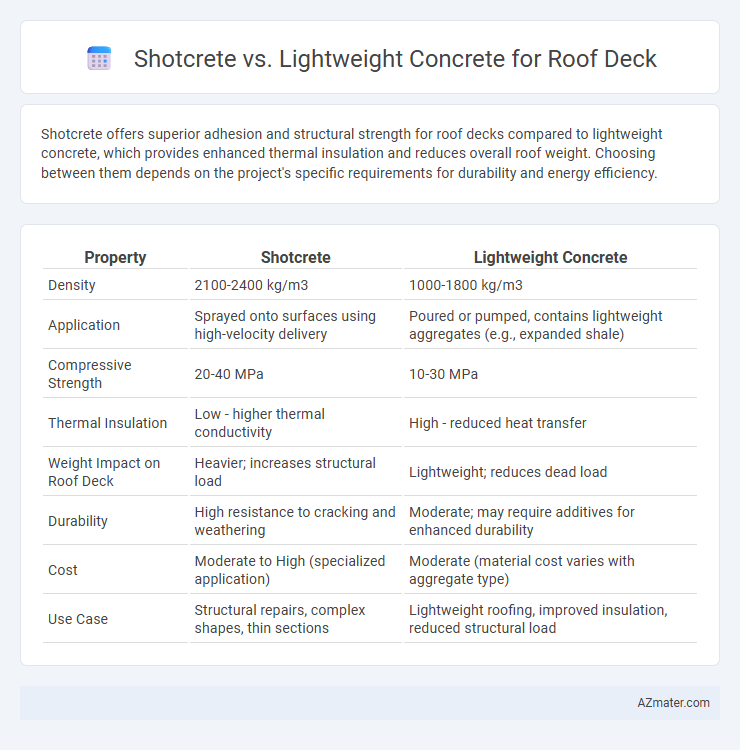Shotcrete offers superior adhesion and structural strength for roof decks compared to lightweight concrete, which provides enhanced thermal insulation and reduces overall roof weight. Choosing between them depends on the project's specific requirements for durability and energy efficiency.
Table of Comparison
| Property | Shotcrete | Lightweight Concrete |
|---|---|---|
| Density | 2100-2400 kg/m3 | 1000-1800 kg/m3 |
| Application | Sprayed onto surfaces using high-velocity delivery | Poured or pumped, contains lightweight aggregates (e.g., expanded shale) |
| Compressive Strength | 20-40 MPa | 10-30 MPa |
| Thermal Insulation | Low - higher thermal conductivity | High - reduced heat transfer |
| Weight Impact on Roof Deck | Heavier; increases structural load | Lightweight; reduces dead load |
| Durability | High resistance to cracking and weathering | Moderate; may require additives for enhanced durability |
| Cost | Moderate to High (specialized application) | Moderate (material cost varies with aggregate type) |
| Use Case | Structural repairs, complex shapes, thin sections | Lightweight roofing, improved insulation, reduced structural load |
Introduction to Shotcrete and Lightweight Concrete
Shotcrete is a method of applying concrete projected at high velocity onto surfaces, offering superior adhesion and density, making it ideal for reinforcing roof decks with complex shapes. Lightweight concrete incorporates lightweight aggregates such as expanded clay, shale, or pumice, resulting in reduced dead load and improved thermal insulation for roof applications. Both materials provide distinct benefits in structural performance and energy efficiency, influencing roof deck design choices based on load capacity and insulation requirements.
Key Differences Between Shotcrete and Lightweight Concrete
Shotcrete is a concrete application method where a mixture is pneumatically projected onto surfaces, offering high strength and excellent bonding, making it ideal for complex roof deck shapes and structural repairs. Lightweight concrete uses lightweight aggregates such as expanded shale or clay to reduce density, providing superior thermal insulation and reducing dead load on roof structures. Key differences include shotcrete's method of application and quick setting properties versus lightweight concrete's composition aimed at weight reduction and thermal performance.
Composition and Material Properties
Shotcrete for roof decks is a pneumatically applied concrete mixture combining cement, sand, water, and aggregates, offering high compressive strength and excellent adhesion to substrates. Lightweight concrete incorporates lightweight aggregates such as expanded clay, shale, or pumice, reducing density and thermal conductivity while maintaining sufficient load-bearing capacity. The choice between shotcrete and lightweight concrete depends on structural requirements where shotcrete excels in durability and bonding, whereas lightweight concrete prioritizes reduced dead load and enhanced insulation.
Application Methods and Techniques
Shotcrete application on roof decks involves pneumatically projecting concrete at high velocity, ensuring excellent adhesion and compaction on complex surfaces, which enhances structural integrity and waterproofing. Lightweight concrete is typically cast or sprayed, using specialized mix designs with lightweight aggregates to reduce load while maintaining thermal insulation, requiring careful formwork and curing techniques to prevent shrinkage and cracking. Both methods demand skilled labor and precise moisture control to optimize performance and durability in roofing structures.
Structural Performance for Roof Decks
Shotcrete exhibits superior structural performance for roof decks due to its high compressive strength and excellent bonding capabilities, allowing it to form monolithic, dense layers that withstand heavy loads and seismic forces. Lightweight concrete offers reduced dead load, which minimizes structural stress and improves energy efficiency, but may have lower compressive strength and requires careful mix design to maintain durability under roof deck conditions. Optimizing the concrete mix and reinforcement strategy is critical in both materials to achieve optimal load distribution, crack resistance, and long-term structural integrity for roof decks.
Insulation and Thermal Efficiency
Shotcrete offers excellent structural strength but has lower insulation properties compared to lightweight concrete, making it less effective for thermal efficiency in roof decks. Lightweight concrete, due to its porous aggregate and lower density, provides superior insulation, reducing heat transfer and improving energy savings. Enhanced thermal performance in roof decks using lightweight concrete contributes significantly to maintaining stable indoor temperatures and reducing HVAC costs.
Weight Considerations and Load-Bearing Capacity
Shotcrete offers higher density and greater compressive strength compared to lightweight concrete, making it suitable for roof decks requiring robust load-bearing capacity. Lightweight concrete significantly reduces the overall roof weight, easing structural demands and enhancing seismic performance but with lower compressive strength. Weight considerations favor lightweight concrete for structures with strict load limits, while shotcrete is preferred for heavier load applications due to superior durability and density.
Cost Comparison and Budget Impact
Shotcrete typically costs between $85 and $125 per cubic yard, while lightweight concrete ranges from $100 to $150 per cubic yard, making shotcrete a more economical option for roof decks. The lower material and labor costs associated with shotcrete reduce overall project expenses and minimize budget impact significantly. Choosing shotcrete can lead to savings of up to 20% compared to lightweight concrete, especially in large-scale roof deck applications.
Durability and Maintenance Requirements
Shotcrete offers superior durability for roof decks due to its dense, uniform application that resists cracks and weathering better than lightweight concrete, which often contains air pockets that may reduce structural integrity over time. Maintenance requirements for shotcrete are minimal, with routine inspections to address minor surface degradation, whereas lightweight concrete may demand more frequent repairs to combat spalling and moisture infiltration. Choosing shotcrete enhances the longevity of roof decks while lowering long-term maintenance costs compared to lightweight concrete solutions.
Best Use Cases and Recommendations for Roof Decks
Shotcrete offers superior adhesion and structural strength, making it ideal for complex roof deck geometries and retrofit applications where durability is critical. Lightweight concrete excels in reducing dead load, improving thermal insulation, and minimizing structural support requirements, which is best suited for new constructions requiring energy efficiency and speed. Roof decks exposed to heavy loads or requiring high impact resistance benefit most from shotcrete, while lightweight concrete is recommended for large-span roofs and climates demanding enhanced thermal performance.

Infographic: Shotcrete vs Lightweight Concrete for Roof Deck
 azmater.com
azmater.com